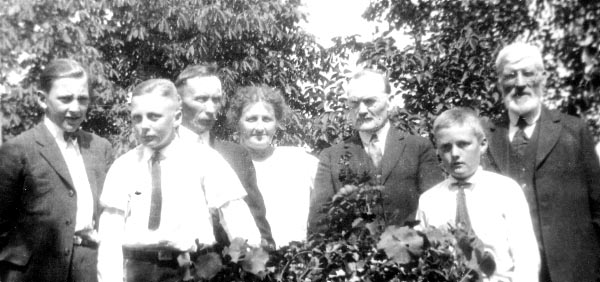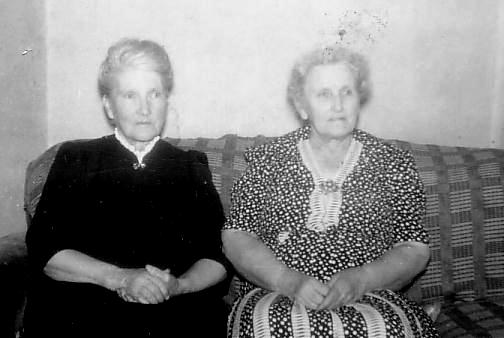Mathison
John Peter Mathison (1843-1930)Johan Petter Mathiassen, my great-grandfather, was the son of Mathias Davidsen (1813-1894) and Johanna Johnsdatter (1811-1892) of Korgen Sogn, Hemnes Prestegjeld, Norway. The family farm, Bjurselvmoen, was adjacent to the Reinaamoen farm, and on June 30, 1867, Johan married Lovise Zakrine Larsdatter (1835-1913), who lived on the Reinaamoen farm. Both families were already inter-related, however, as Lovise was a first cousin, once removed, of Johan. Her father was Lars Gabrielsen (1790-1872) and her mother was Zacharina Kierstina Samuelsdatter (1798-?). At some time early in their marriage, perhaps even before, the couple decided that their future was to be in America. Shortly after their daughter, Sakrine, was born on November 29, 1868, they began to prepare for the voyage. At the end of April, 1869, they set off for Namsos, a port relatively near to Hemnes. There, with their 5-month-old daughter, they boarded the bark New Brunswick on May 7. The voyage from Namsos to Quebec City took six weeks and was difficult in the extreme for the 246 passengers. Although one baby was born during the voyage, five children died, as did two men, one of pneumonia. From Quebec City, the little family traveled first to Minnesota. There, they moved in with the family of Christopher Larson, Lovise's brother. He had immigrated three years earlier, along with his wife, Anne, their son Lars, and Ludvig, his 22 year-old half-brother. Lovise helped with housekeeping and Johan worked as a laborer on the farm. Within about two years they had earned enough money to consider striking out on their own. The Northern Pacific Railroad was pushing west across the Red River Valley and into what is now North Dakota, near the U.S. Army's Fort Abercrombie, and early settlers in the region were reporting that the land was rich and fertile. So, probably in 1871, the Mathisons traveled again, this time to Richland County in the Dakota Territory. They stopped just a few miles south of the newly formed settlement of Fargo. Part of the Great Northern Plains, the area is vast and treeless, but would grow excellent wheat. In all probability the family lived and worked on someone else's farm for several years, for they did not buy their own land until much later, nor did they begin homesteading right away. They undoubtedly lived in a sod house, for wood was scarce and extremely expensive. Life was hard and Indians often a threat, but chickens and eggs could be grown and sold, often to the soldiers at nearby Fort Abercrombie. Surplus wheat could be taken by wagon for sale in a town about 100 miles away. It was probably not long before their names were 'Americanized' to John Peter and Louise Mathison. Sakrine became Serena. A daughter, Mathea, was born in 1872, followed by Hannah (1874-1935), and Christine (1876-1956). My grandmother, Gertie Johanna, was born in 1877, and her brother Martin (1882-1962) rounded out the family. They were not alone in the area, either. Peder Mathisen, Johan's brother, had left Norway in 1876 and began homesteading an adjacent 160 acres. He obtained the patent for his farm in September, 1884. By 1881, they were able to strike out on their own. They started with 76 acres purchased from the U.S. government, and homesteaded an additional 76 acres, which they finally acquired in March, 1886. (The Homestead Act of 1862 required that they improve the property, and live on it for five years in order to obtain title to the land.) Below is a copy of the patent the family received in March,1886, for the land they had homesteaded. 
As soon as they obtained title to their final 76 acres, however, they sold the farm and moved to Alpha, a small farming community in Lewis County in the state of Washington. There they purchased an 80 acre farm for $1200. The property was located on the north side of the Centralia-Alpha road. Louise Mathison is shown at left, standing on the porch of their home. Mathea died there in 1892 and is buried in a small cemetery near the family farm. Her brother Martin made a small marker for her grave and was himself buried next to her when he died in 1962. Christine and my grandmother eventually moved to Tacoma and found jobs in a laundry. Nothing more is known of Serena, however, and it is not even known if she came to Alpha with the rest of the family. John and Louise Mathison moved to Tacoma in 1897 but the farm in Alpha was not sold (for $1600) until 1901. Louise died on April 9, 1913,at the age of 78. Hannah married Nick Andersen (my grandfather's brother) and died in Tacoma in 1935. Christine died there in 1956, never having married, and it was there that my grandmother met John Andersen at the Norwegian Lutheran Church they both attended. They were married on March 29, 1902 and my father, Alton Jessmar Andersen, was born in 1907. He was an only child, as was my mother, so I have no aunts, uncles, or first cousins! John Peter Mathison passed away in 1930, having learned little or no English since his arrival in the United States over 60 years earlier. 
Gertie Johanna Mathison (1877-1959)Gertie left the family home in Alpha, Washington, as a young woman and found employment at a laundry in Tacoma. After meeting and marrying my grandfather, the little family lived in Tacoma, where my father was born. Norwegian was spoken in the family whenever my great-grandfather Mathison visited, so my father grew up speaking both English and Norwegian. On the death of his grandfather, Dad and his parents no longer spoke Norwegian very often, and they gradually lost the language. Following the death from cancer of my grandfather, my grandmother lived by herself much of the time, except for the period when she lived with us. Apparently she and my mother did not get along in such close proximity, so Grandma spent the rest of her life in a rented home or apartment of her own. I remember many enjoyable visits with her, many spent watching as she made and drank her incredibly thick and potent coffee, or cooked or baked a Norwegian specialty. 'Flatbread', for example, was made of dough that had been rolled paper-thin, then 'baked' on top of her wood stove. She had a three-foot long wooden dowel, pointed at one end, that she used to slide under the bread, lift it up, and flip it over.

Always intensly religious, Grandma Andersen (shown above, on the right, with her sister Christine) attended a Lutheran church for many years, then changed to a Pentecostal one. Her Bible was always at her bedside, and there were always a religious picture or two hung on a wall. I well remember a pump-organ in her living room although I do not remember her ever playing it. She was 82 years old when she died in 1959.

|